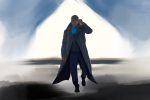Sherlock Holmes is one of the most well-known characters in pop culture, and he and Doctor Watson are one of the most iconic duos. Holmes is the most portrayed character on screen with around 254 appearances in film and television. While Sherlock Holmes wasn’t the first detective in literature — Edgar Allen Poe’s C. Auguste Dupin came before him — he is certainly the most famous. Holmes is the blueprint for many investigators, and items such as the curved pipe, deerstalker hat and magnifying glass are now synonymous with detectives.
Sir Arthur Conan Doyle, the author of the Sherlock Holmes stories, based Holmes off of his mentor, Dr. Joseph Bell. Bell was able to deduce things about his clients just by looking at them. For example, he could tell where sailors had been from the tattoos they had. Doyle invented Holmes and gave him these deductive abilities to solve crimes rather than work with patients. Doyle debuted Holmes in 1887 with the novel “A Study in Scarlet.”
The novel is narrated by Dr. Watson, an army soldier returning from the Second Afghan War. He searches for a place to live and, through a mutual acquaintance, meets Sherlock Holmes. Watson moves into 221B Baker Street, where he quickly discovers Holmes’ strange habits and odd career. Watson follows Holmes as he investigates a strange murder case involving poison pills, a vengeful American cab driver and the German word “rache” written in blood on the wall. After seeing that Holmes gets no credit in the newspaper report, Watson decides to write down Holmes’ adventures to give him the credit he deserves. From there, Doyle wrote three other novels and 58 short stories about the adventures of Sherlock Holmes.
Eventually, Doyle grew tired of his famous characters. He was the author of many other books, but Holmes was the one that got the most attention. This bothered him deeply, as he considered his other works to be much more important. In “The Adventure of the Final Problem,” Doyle introduced the criminal mastermind Professor Moriarty. He and Holmes meet their ends by falling from the Reichenbach Falls. There was public backlash, and Doyle eventually brought Holmes back after he was offered a large sum of money. Holmes reappeared in “The Hound of the Baskervilles,” then returned officially in “The Adventure of the Empty House.”
Sherlock Holmes has been appearing on screen since the invention of film. His first appearance was in the silent film “Sherlock Holmes Baffled.” Basil Rathbone famously played the detective, and so did Christopher Lee, Peter Cushing and Tom Baker among others. Jeremy Brett played Holmes in the Granada Television series that aired from 1984 to 1994. More modern adaptations, such as the Guy Ritchie films and BBC’s “Sherlock” have seen Holmes played by Robert Downey Jr. and Benedict Cumberbatch respectively.
Adaptation usually means that certain things will be cut, changed or added, and Sherlock Holmes is no exception. The Granada Series, while very faithful to the source material, changed the order of some of the stories. “A Scandal in Bohemia” was the first episode in the series and the third Holmes story; “A Study in Scarlet” was never even adapted. Also, Watson never married Mary Morstan at the end of “The Sign of the Four.”
The Guy Ritchie films, consisting of “Sherlock Holmes” and “Sherlock Holmes: A Game of Shadows,” are more like action movies than mysteries. The first revolves around an original character, Lord Blackwood, and the strange, seemingly occult murders that he commits. The second movie draws on many plot elements from “The Final Problem,” but is ultimately about preventing Professor Moriarty from jumpstarting the Great War. Holmes’ deductions are more like superpowers, and he uses them to win fights.
BBC’s “Sherlock” transplanted Holmes and Watson into contemporary London. The series started out as relatively faithful to the books — the pilot episode, “A Study in Pink,” featured a murderous cab driver, “rache” as a clue and Holmes and Watson meeting through a mutual acquaintance. But the series began departing more and more from its source material as time went on. BBC’s “Sherlock” was said to have jumped the shark by making Mary Morstan an assassin and creating a third, smarter Holmes sibling.
While these adaptations are different from one another, they all maintain the same premise and the same general cast: Holmes, Watson, Mrs. Hudson, Professor Moriarty, Mycroft Holmes, Inspector Lestrade and Irene Adler.
Every version of Sherlock Holmes maintains his deductive abilities and his eccentric character. But some versions exaggerate these traits: The Ritchie films and BBC’s “Sherlock” turn Holmes’ deduction into a superpower, giving him the ability to predict actions in seconds and have a full-fledged “mind palace.” Adaptations also often exaggerate Holmes’ aloofness. While he could be solitary in the books, he never considered himself a “high-functioning sociopath.”
Earlier versions of Watson, such as Nigel Bruce’s version played alongside Rathbone, could sometimes be depicted as incompetent. While Watson was never quite as observant as Holmes, he was just as capable and often played the brawn to Holmes’ brain. More modern adaptations like the Guy Ritchie films have depicted Watson as closer to his original counterpart.
Professor Moriarty is often given much more weight in adaptations than in Doyle’s original stories. Moriarty is only introduced as a way to kill off Holmes and is used only once more in the novel “The Valley of Fear.” Though Moriarty is only used twice, his introduction as a dangerous criminal mastermind and an equal match for Holmes gives the character a lot of weight. In many adaptations, Moriarty is killed when he falls off the Reichenbach Falls. BBC’s “Sherlock” shows a very different version. In it, Moriarty has ties to every criminal Holmes faces. He is also a young man and not a professor. BBC’s Moriarty dies after shooting himself to spite Sherlock.
Minor characters such as Mrs. Hudson, Inspector Lestrade and Mycroft Holmes are rarely changed. Mrs. Hudson remains a put-upon landlady, Inspector Lestrade can never quite hold his own and requires Holmes’ help, and Mycroft is Holmes’ smarter but lazier brother. One character who is too often misinterpreted is Irene Adler.
Irene Adler’s first and only appearance is in “A Scandal in Bohemia.” In the story, the future king of Bohemia comes to Holmes with a problem. He is set to be married to a Scandinavian princess, but a woman from a previous secret relationship has a photograph of them together, and he fears that he will be blackmailed. This woman is Irene Adler, an opera singer from New Jersey. Holmes infiltrates Irene’s home in disguise and discovers the location of the photograph. Irene, however, sees through Holmes’ tricks. She departs from England and leaves Holmes a note explaining that she saw through his disguise and that she only kept the photograph to protect herself from the king. Holmes realizes that he was in the wrong, tells off the king and shows a great deal of respect for Irene.
Holmes and Irene are paired up in quite a few adaptations, which is a strange choice considering the source material. While Holmes has a great deal of respect for her and calls her “The Woman,” there is no indication that he had any romantic interest in her. Additionally, Irene marries another man, Godfrey Norton, and leaves England with him at the end of “A Scandal in Bohemia.”
While the Granada series understood the character of Irene Adler, BBC’s “Sherlock” and the Guy Ritchie films don’t. In “Sherlock Holmes,” Irene is the Catwoman to Holmes’ Batman. She works for Moriarty and is generally morally gray. In “A Game of Shadows,” Irene is fridged; Professor Moriarty kills her and uses her death as a threat toward Holmes.
BBC’s “Sherlock” butchers Irene Adler’s character the most. While the original Irene is innocent and escapes Holmes, BBC’s Irene is a blackmailer who works for Moriarty and falls in love with Sherlock. Irene makes the password on the phone that contains all of her blackmailing material “Sherlocked” because of her infatuation with him. Holmes outwits Irene, beats her and then saves her from being beheaded. While these versions of Irene appear to play a more active role in the plot, the point of her character is ultimately lost in translation.
The many versions of the Sherlock Holmes stories reveal the nature and the pitfalls of adaptation. While the Sherlock Holmes stories are generally the same on the surface, many things are changed — sometimes for the worse. This is especially apparent in the case of Irene Adler, whose character is often changed to the point of being unrecognizable.

















